Light Curves of KAFO Candidates
Recent Updates:
Oct 29: K00377.01 by Gary; nothing (but
none expected)
Aug 10: K00410.01 by Mendez; non-detection (1.6
sigma)
Jul 29: K00377.01 by Garlitz; no show!
Jul 18: K00410.01 by Garlitz; late 25 +/- 3
min. Expected depth & length.
Jul 11: K00377.01 by Salas; 3.4 hrs early
(assuming a length with 0.2 hr a priori SE!
Jul 11: K00774.01 by Garlitz; compatible w
ephem
Jul 05: K00620.01 by Mendez; data
insufficient for assessing presence of transit
Jun 05: K00774.01 by Salas; compatible
w ephem
May 22: K00190.01 by Garlitz; not
enough pre-ingress to be useful
Apr 22: K00806.02 by Benni. Partial
ingress but can't be sure ingress was detected.
Apr 19: K03506 by Benni. Ing only.
Apr 14: K05722 by Benni. Ing & egr,
no mid.
___________________________________________________________________________________________________________
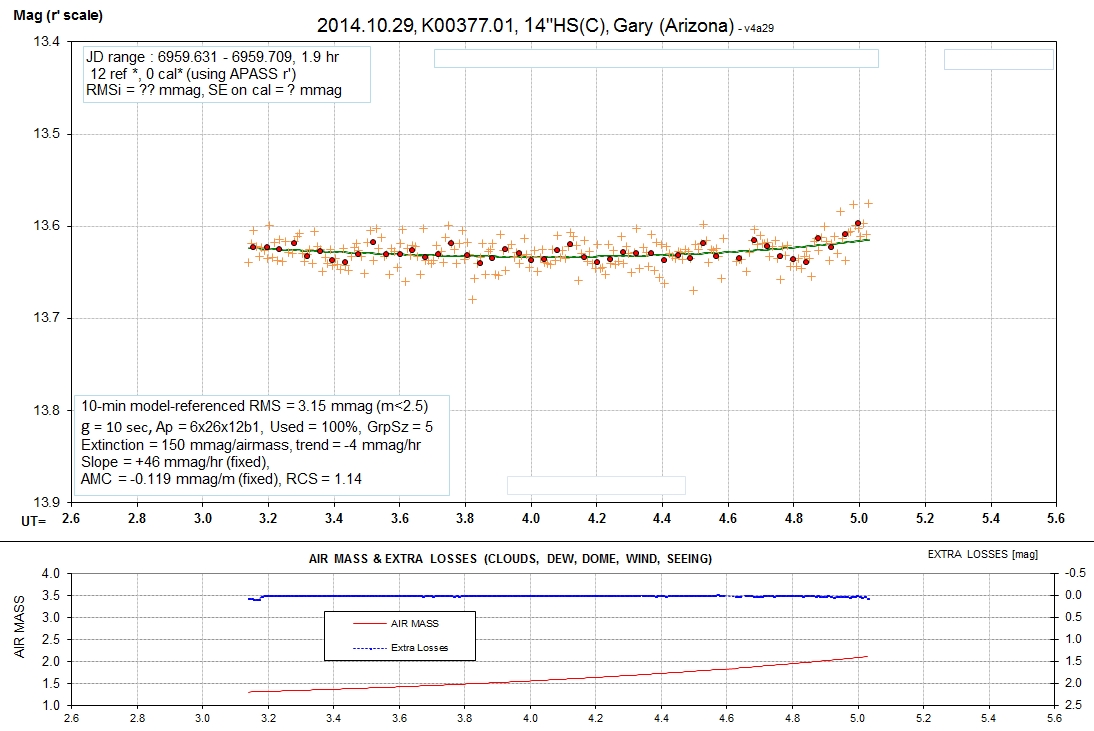
Predicted ephemeris is "all over the place" so I just observed to
see if anything who show up. Nothing did.

Non-detection. Star too faint, & depth too small, for this
aperture.

A "no show" - implying big TTV, like the other LCs for this
target.

Looks noisy, but statistics say to believe the solution.

3.4 hrs early!

Good quality; agrees with ephemeris. Too bad ingress couldn't be
captured. I adopted a "liberal" a priori uncertainty for length
(0.3 hr) for this Bayesian solution.
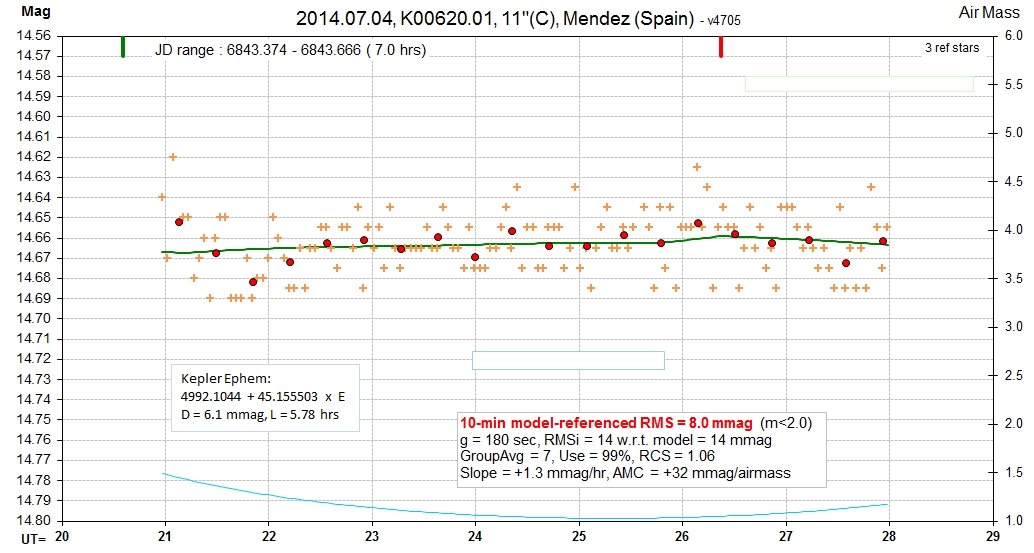
Nice try, but this event was just too difficult for a
11-inch aperture (~ 30 inches was needed).
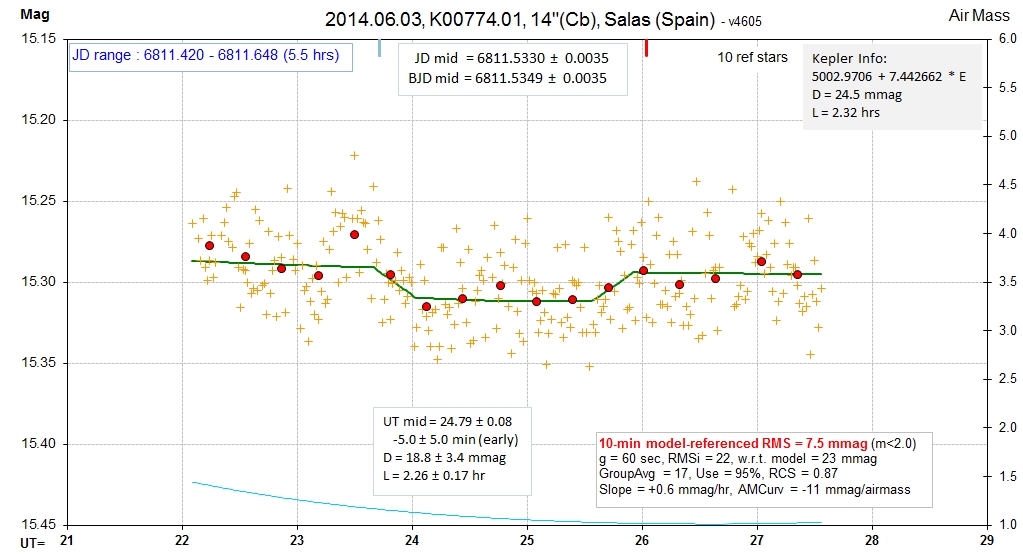
Mid-transit time is compatible with the ephemeris. Depth
is slightly smaller & length is the same.
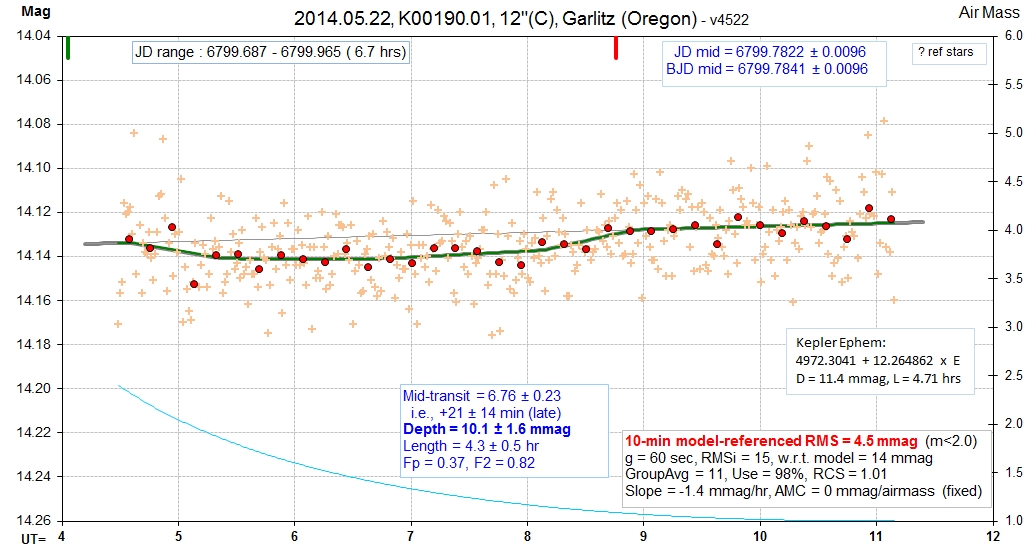
Due to lack of pre-ingress OOT the mid-transit time is too
uncertain to be useful. (Amplitude of TTV ~ 9 min according to
Relles)
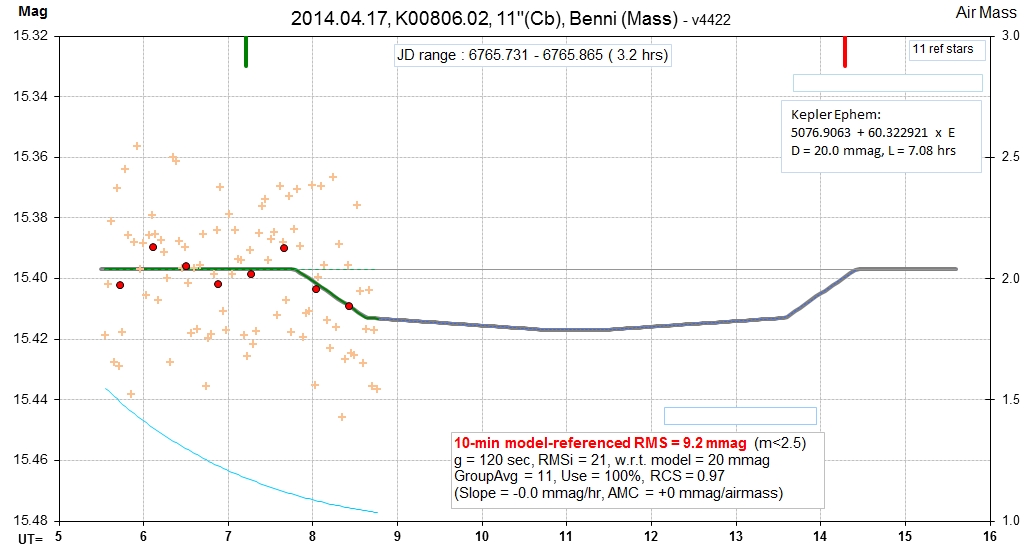
Valiant try, but dawn came too early. Won't include downloadable
data file because this data shouldn't be used for TTV analysis;
this LC is "suggestive"!
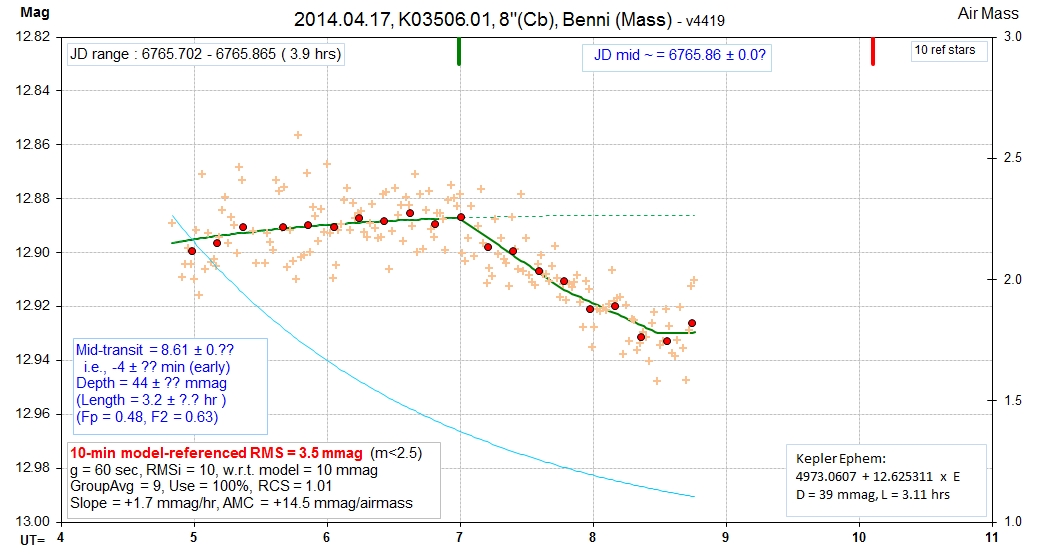
Nothing unexpected. No downloadable data file because
this data shouldn't be used for TTV analyses.

Too bad about the clouds. I include this LC because of the long
period & possible info on changes from Kepler observations.
Depth is much greater & transit occurs ~ 43 min early. No
downloadable data file because this data shouldn't be used for TTV
analyses.

Missing ingress. Depth of ~ 7 mmag is similar to 5.5 mmag meas'd
by Mendez last year, and both are less than Kepler's 21 mmag.
No downloadable data file because this data shouldn't be used for
TTV analyses.
===================== END OF SEASON #1
====================================
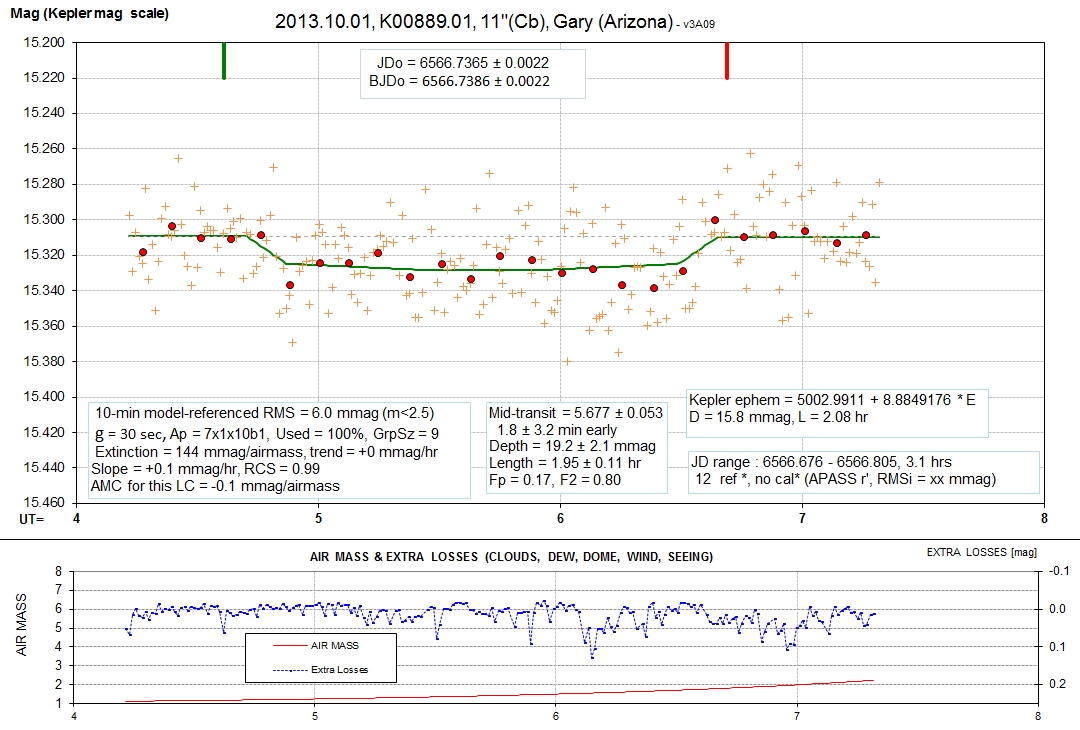
data
Confirmation; no evidence for TTV.
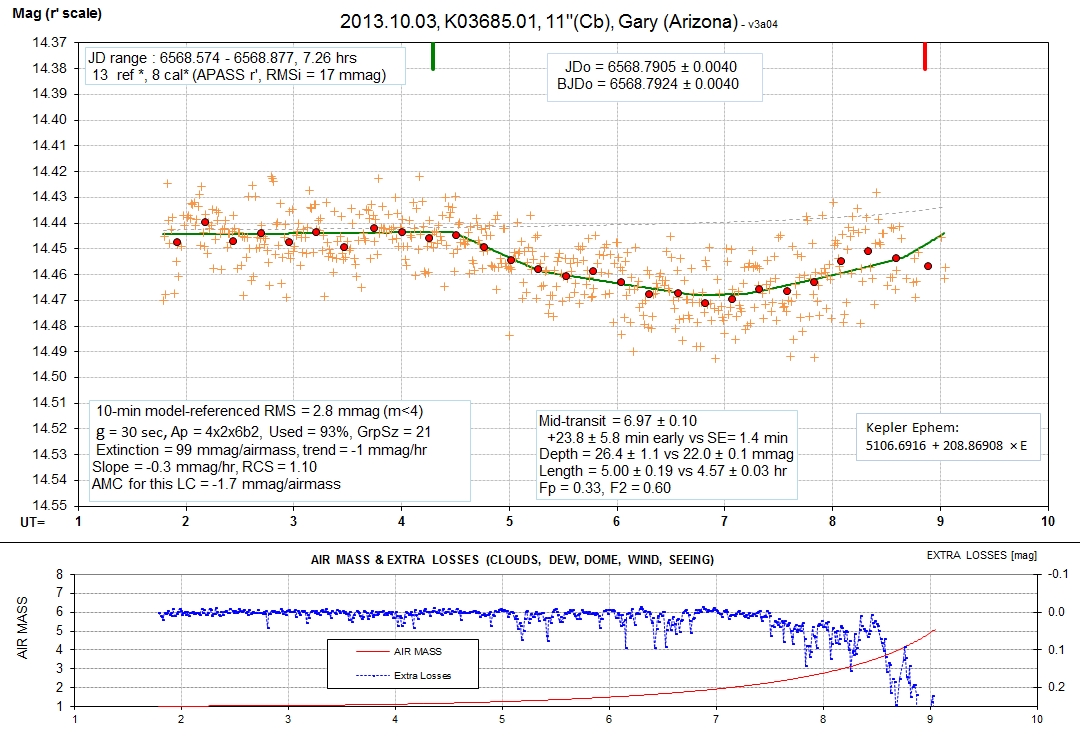
data
Probably a grazing EB, considering transit shape, long period,
short length and deep depth. Lateness of mid-transit is
statistically significant.
Howard Relles has compared this LC's timing with several Kepler
timing observations in a search for TTV produced by additional
planets: http://exoplanet-science.com/KOI-3685_kafo.html
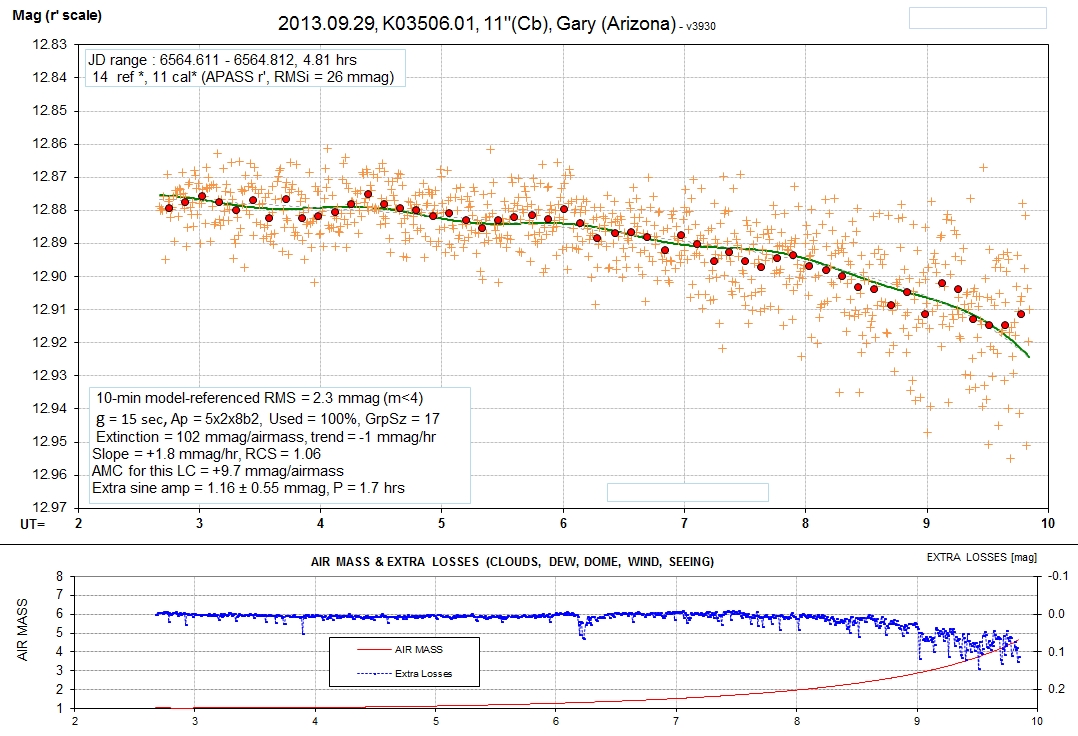
I observed this candidate one day late (misread my own listing!).
The sinusoid fit is not statistically significant, but when this
target is observed again I'll check for it.
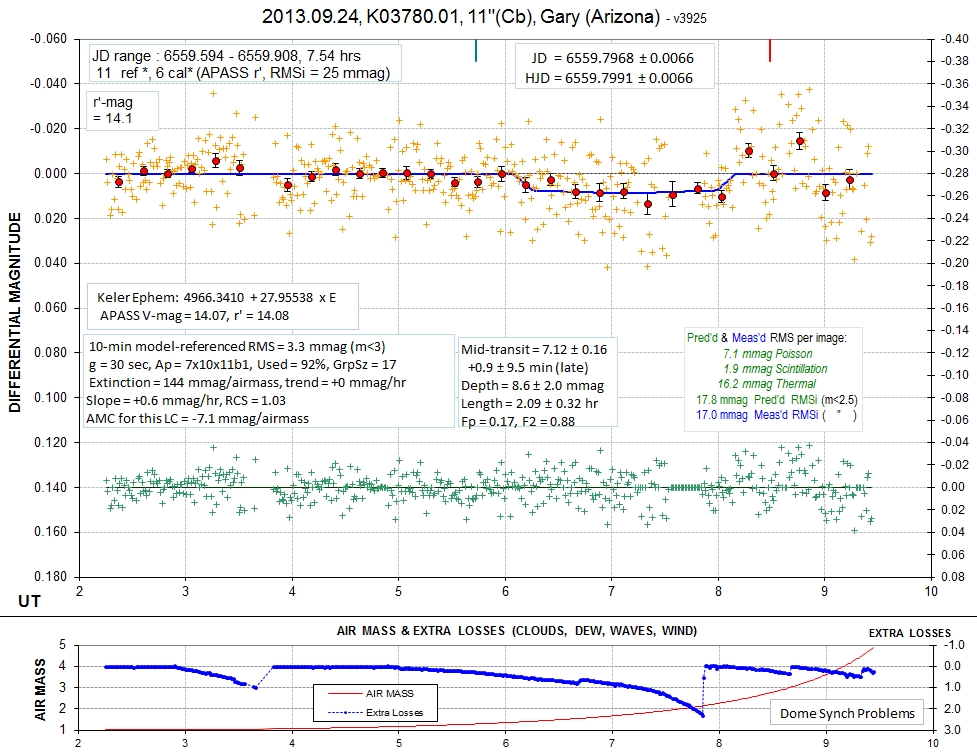

data
Two versions of same data. Mid-transit time is confirmed; no
evidence for TTV. Note: There's an error in the mid-transit
time information box: replace HJD with BJD. (Thanks, Howard, for
noticing this.)
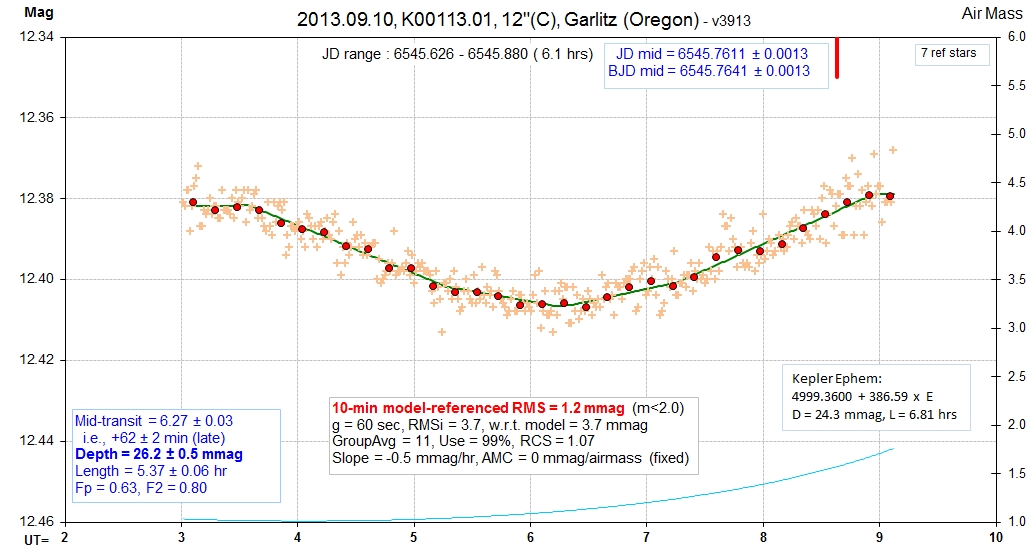
data
Great! This transit is observable just once a year from some
favored longitude, and Joe got it!
I just learned (Sep 13) that this object was recently
dispositioned by the Kepler team as a "false positive."
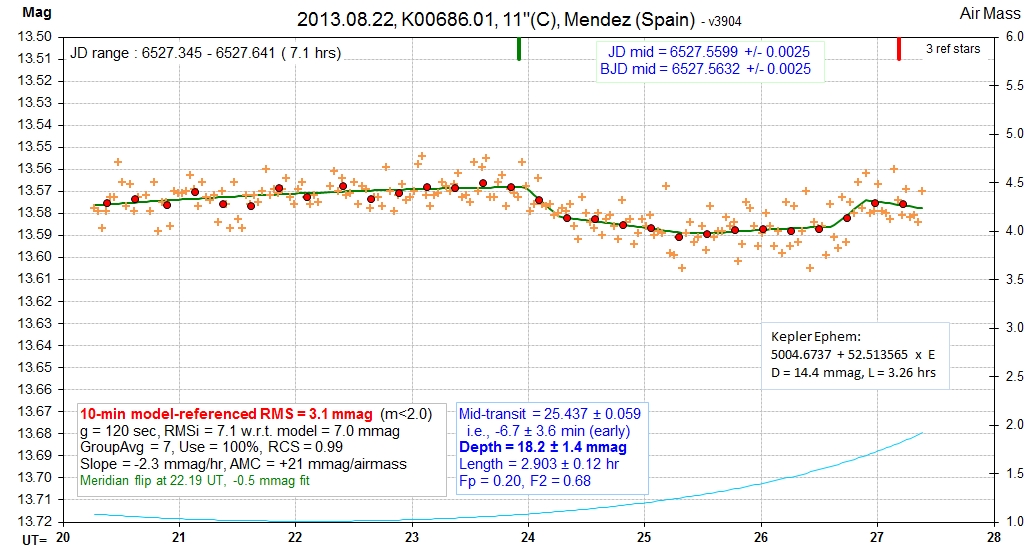
data
Pretty good confirmation, though egress came early.

data
Confirmation of all aspects of Kepler ephemeris for this
candidate.
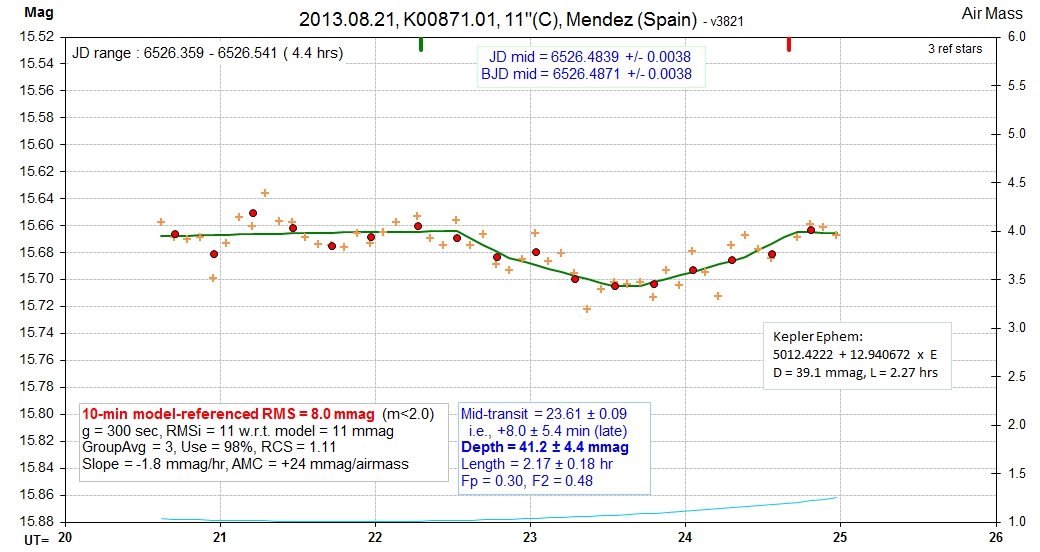
data
Confirmation of 871.01 in all aspects.
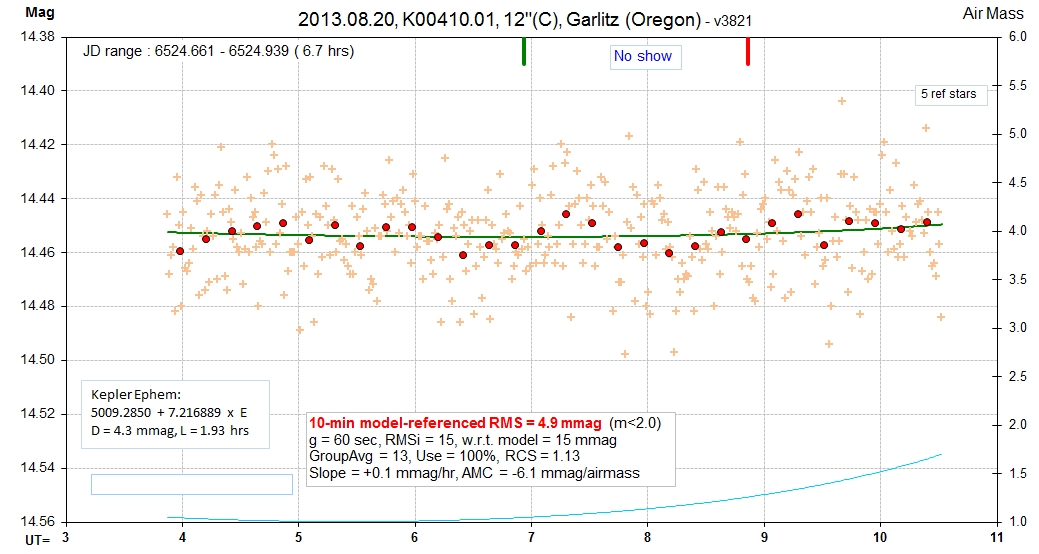
data
On Jul 15 this observer observed a 5.0 ± 1.2 mmag transit 16 ± 6
min late. A 5 nnag transit transit should have been easily
observed on this date.
May I suggest that this object deserves a TTV analysis.
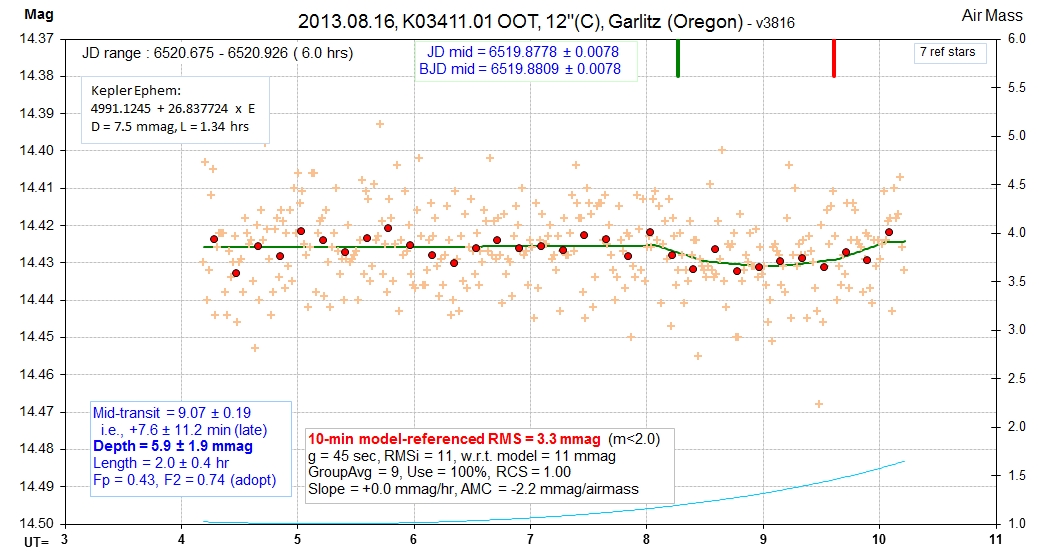
data
Looks real to me. Note: There's a 1-day error in the JD mid
& BJD mid info boxes; they should read 6520.8778 &
6520.8809. (Thanks, Howard, for pointing this out.)
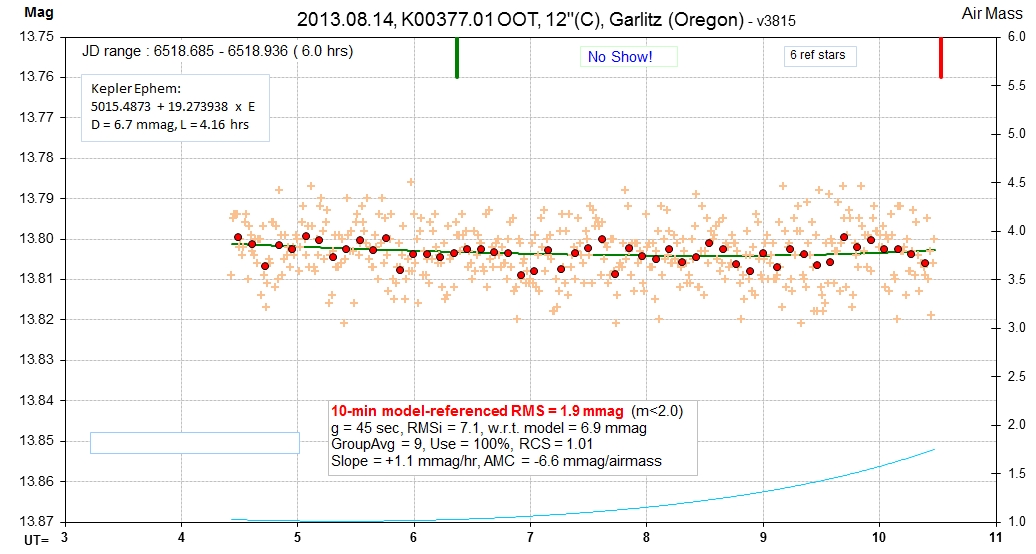
A "no show." Subsequent analysis predicted transit at BJD4 =
6516.6807 (or 2.0 days before the start of this observing
session). This big discrepancy is due to this object being a
3-planet system: Kepler-9b, c and d. The KAFO target list that
prompted Garlitz to observe at this time was based on a linear
extrapolation of all Kepler "b" transits and didn't allow for
celestial mechanic interactions. Dan Fabrycky (Kepler TTV team)
has recently provided us (Aug 19) with a detailed analysis using
all planets to predict that this event should have occurred 2.0
days earlier. Future predictions of transits for this object will
use Fabryky's listing.
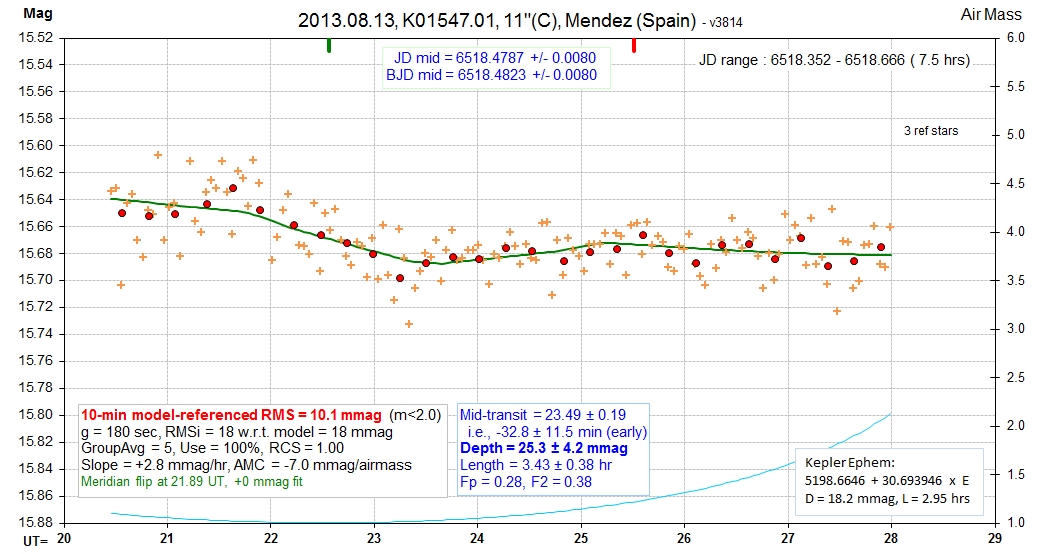
data
Grazing LC. A lttile deeper than the Kepler listing; it came
early (statistically significant) so it might be worth a TTV
analysis.
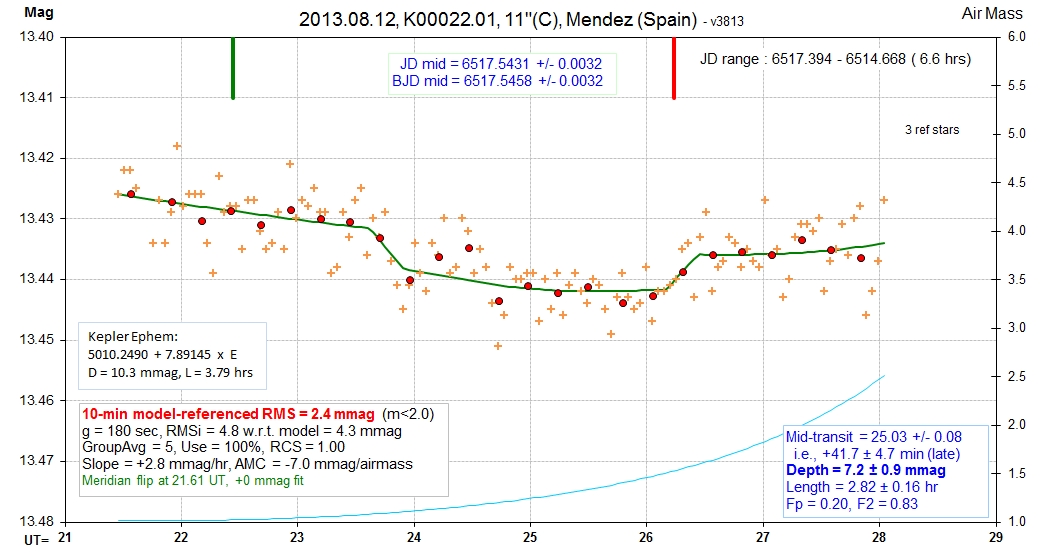
data
Similar depth & length, but mid-transit was late by
significant amount. Maybe a TTV prospect.
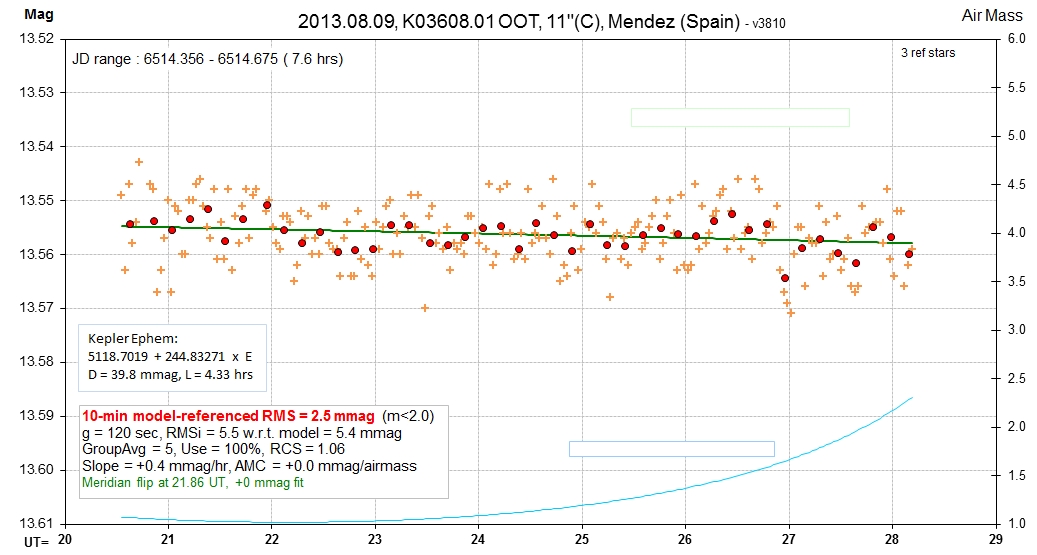
K03608.01 Due to a spreadsheet error that affected some
candidates this object was incorrectly listed for a transit during
this observing session.
Instead, the transit is in October. I apologize to Manuel
for another of my "KAFO growing pains mistakes."

K01465.01 data
Confirming everything!
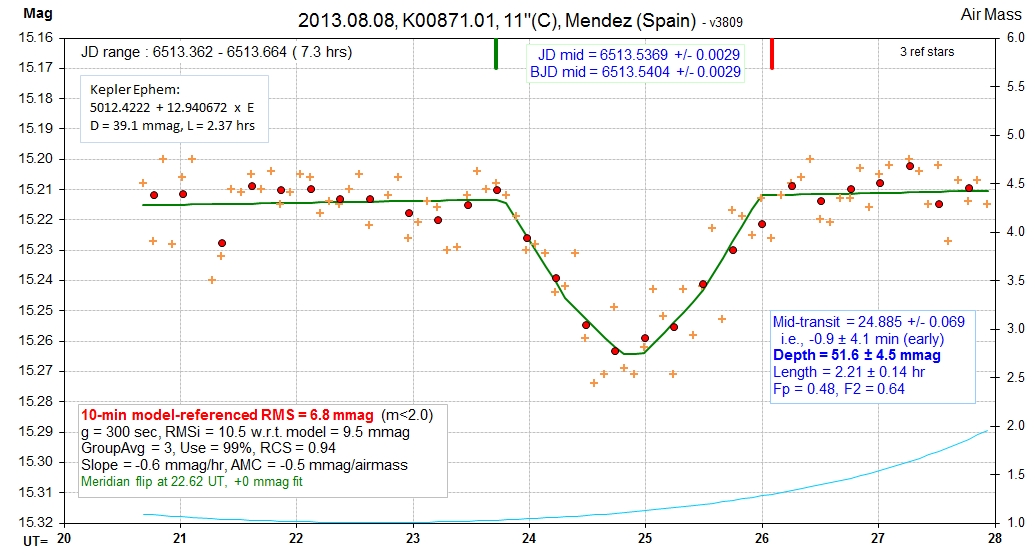
K00871.01 data
Deeper than expected, and "on time!" No trouble with this 15.2
mag star using a 11-inch telescope.


K00774.01 data
Two LC versions of same data: top one is what the professionals
use, bottom one has more information.
The noise is normal (better than previous night's due
to not binning). The 3 main noise sources predict ~18
mmag per image, and 17 mmag per image is measured,
so there are no unaccounted-for noise sources (e.g., "pixel
edge noise" - as occurred the previous night).
These LCs show that a 28 mmag transit is easily observed when
the star has V-mag = 15.43 when using a 11-inch telescope.
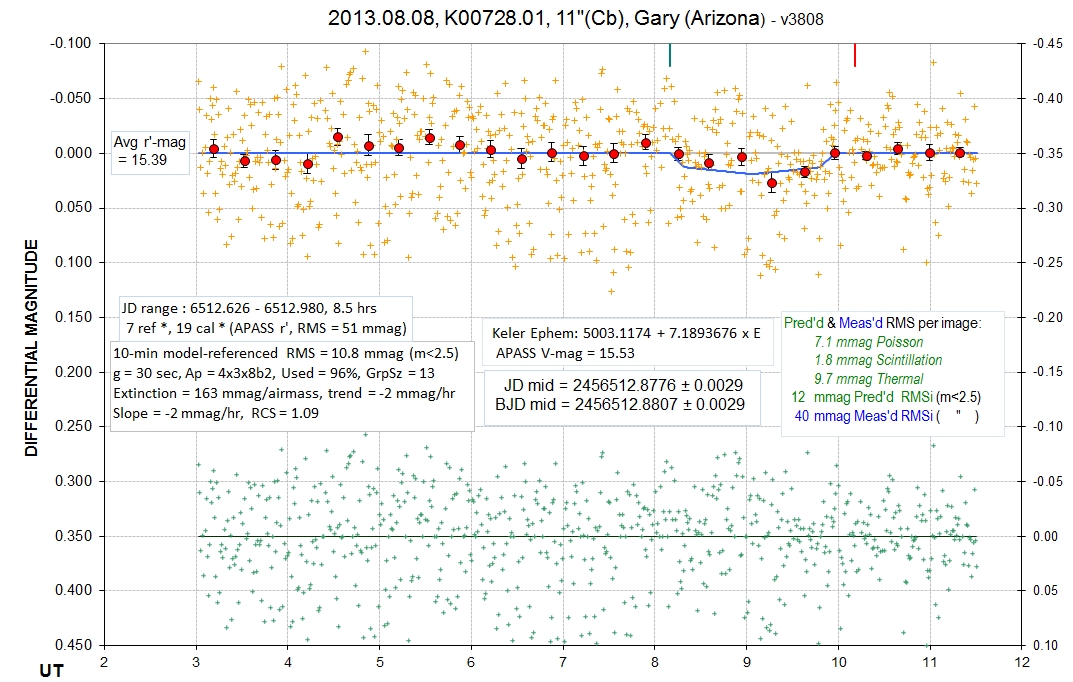
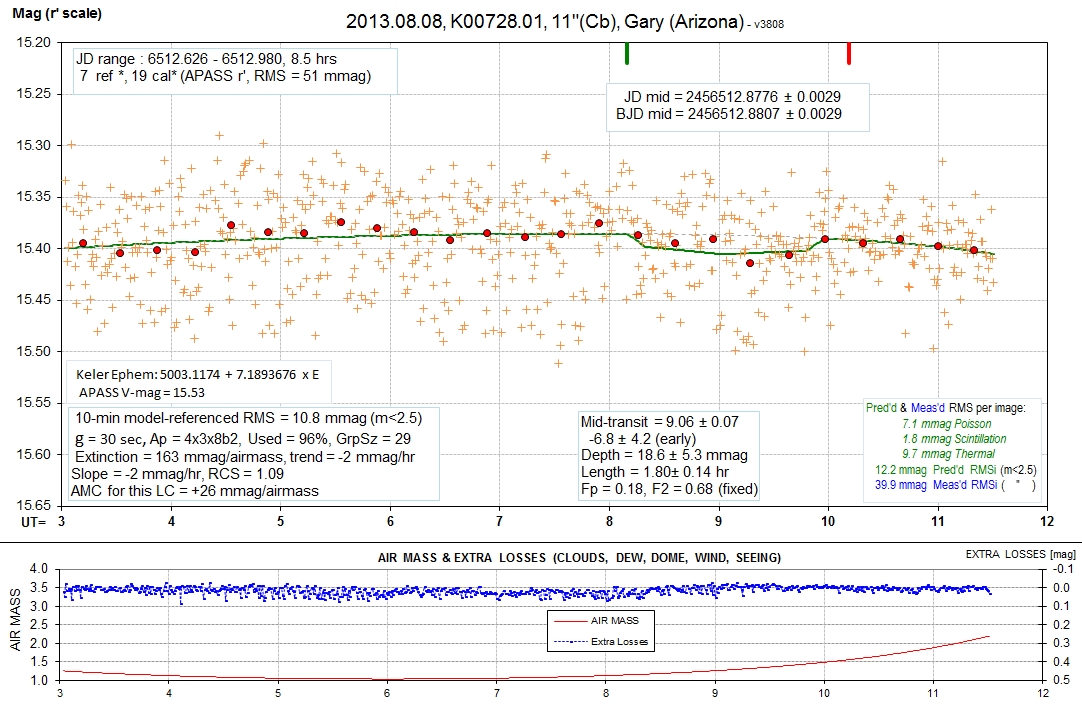
K00728.01 data
Two LC versions of same data: top one is what the professionals
use, bottom one has more information.
The noise is higher than normal because seeing was too
good; PSFs were 1.9 pixels sometimes, causing pixel edge noise.
The 3 main noise sources predict
that scintillation is small, and Poisson and thermal
are comparable; orthogonal sum is ~ 12 mmag per image whereas
actual was ~ 40 mmag. These LCs show that a 19 mmag deep transit
can be observed for a 15.5 mag star (V-mag) using a 11-inch
telescope.
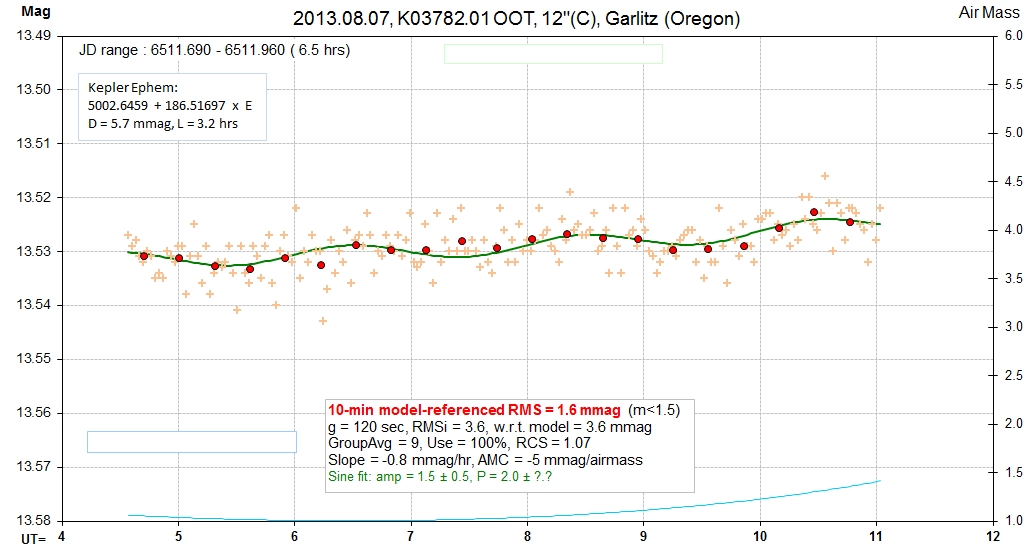
K03782.01 data
The sinusoidal variation is statistically significant
(3.0-sigma); but is it real?

K03782.01 Out-of-transit observation. No sinusoidal variation.
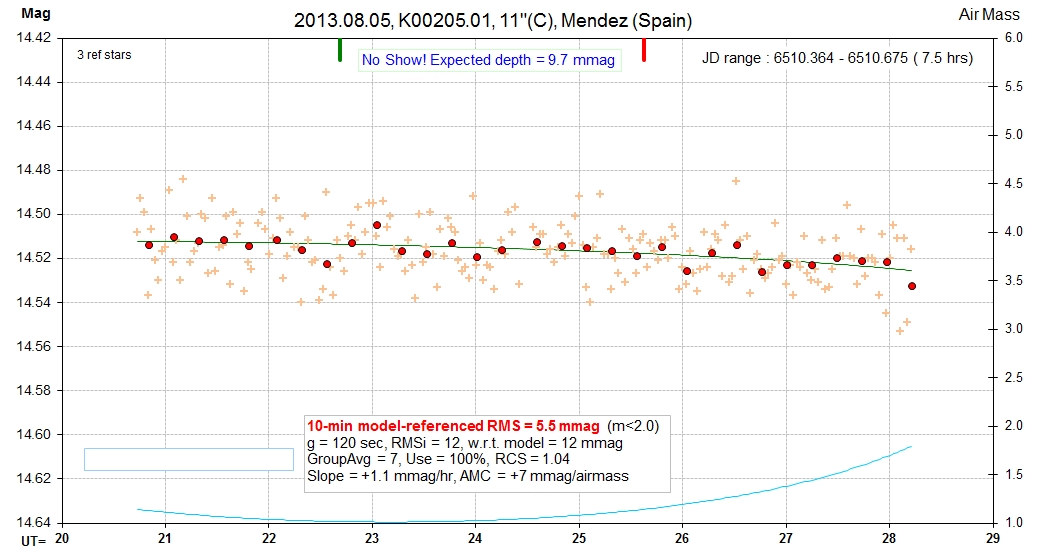
K00205.01 This LC was made for a different Kepler star than the
one that was predicted to undergo transit, due to an error in the
RA/DE coordinated listed in the
prediction table on the KAFO home page; in other words, it's my
fault (Bruce Gary) that the wrong star was observed.

K03597.01 This LC was made for a different Kepler star than the
one that was predicted to undergo transit, due to an error in the
RA/DE coordinated listed in the
prediction table on the KAFO home page; in other words, it's my
fault (Bruce Gary) that the wrong star was observed.

K03782.01 data
The variability is statistically significant (6.8-sigma), but has
longer period than earlier measurements (2.9 vs 1.7 hr).
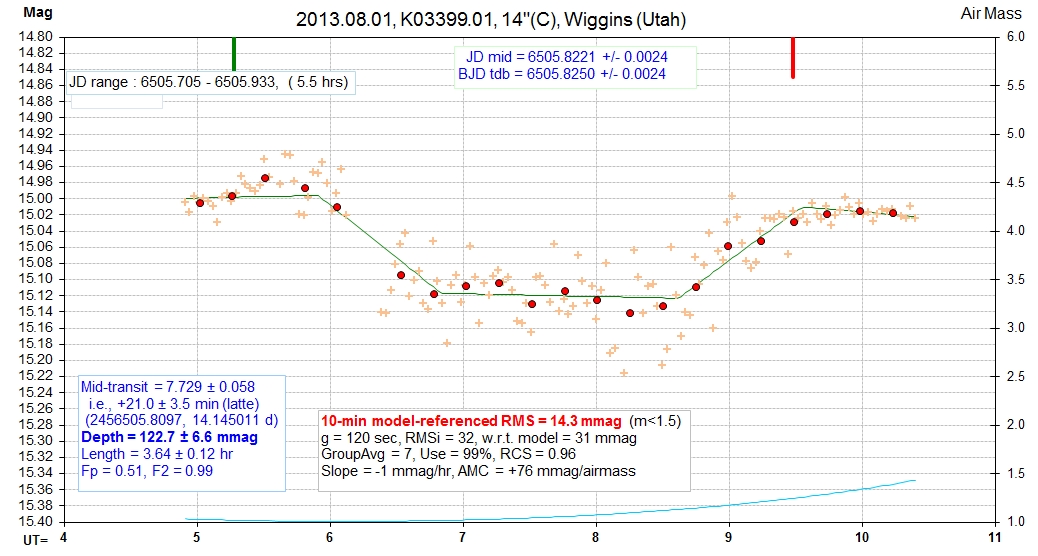
K03399.01 data
Depth of 123 mmag differs greatly from the catalog's 17 mmag. This
one must be an EB. Indeed, it was recently
dispositioned as a "false positive."

K03782.01 data
This LC and te one below overlap in time. They don't support each
other in terms of variation phase or amplitude.
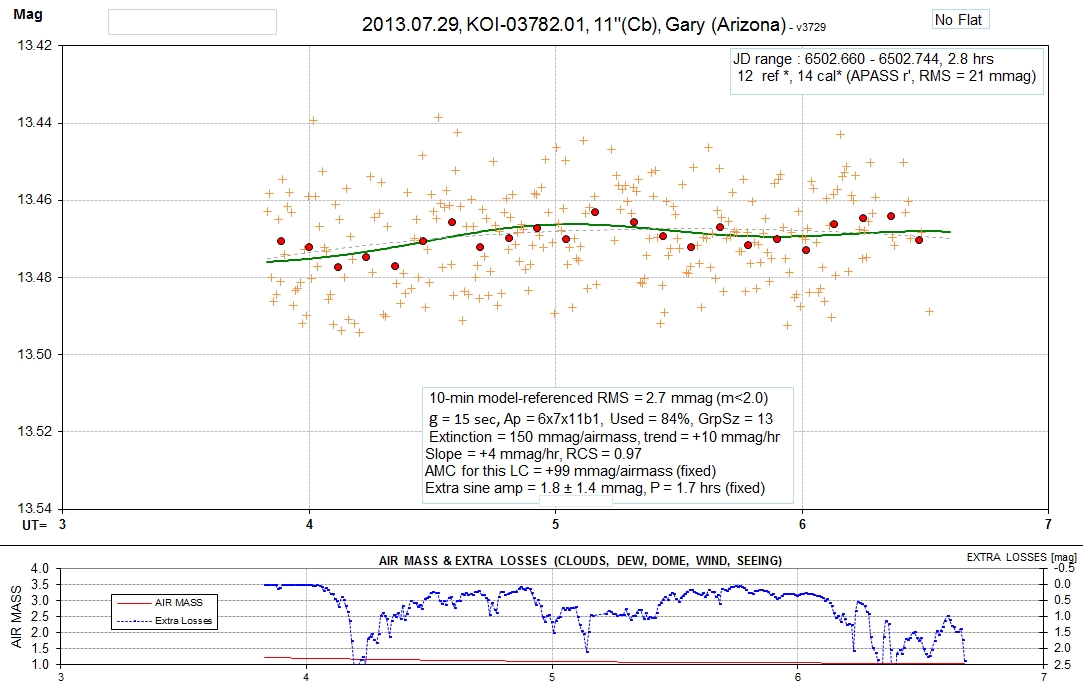
K03782.01 Attempting to confirm Joe's 1.7 hr, 2.2 ± 0.6 mmag
variation (Jul 21). This data is too noisy (clouds?), and
observing session is too short, for comparison.

K00668.01 Confirming ingress time (This object is listed as a
"false positive")
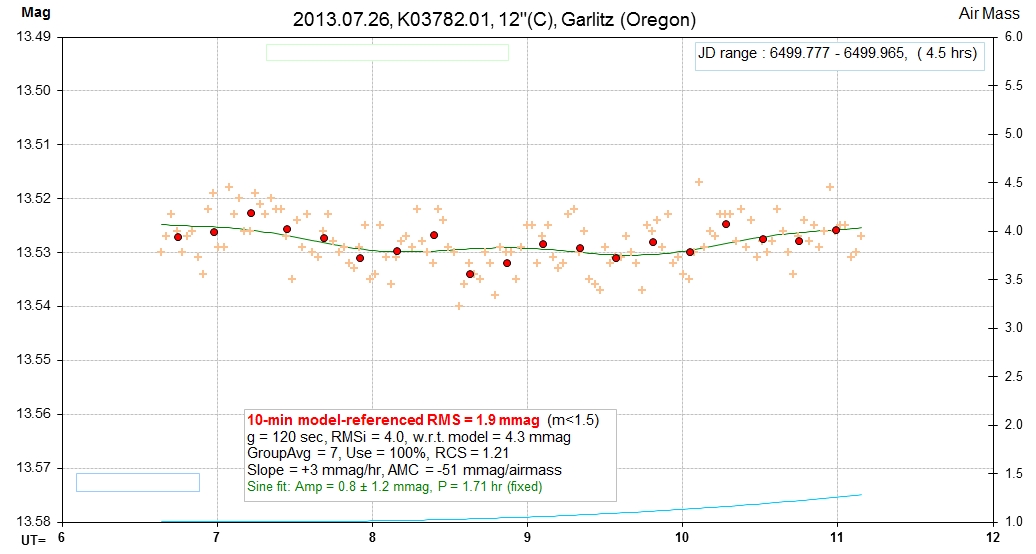
K03782.01 data
No evidence of that 2.2 ± 0.6 mmag, 1.71-hr variation seen
on Jul 21.
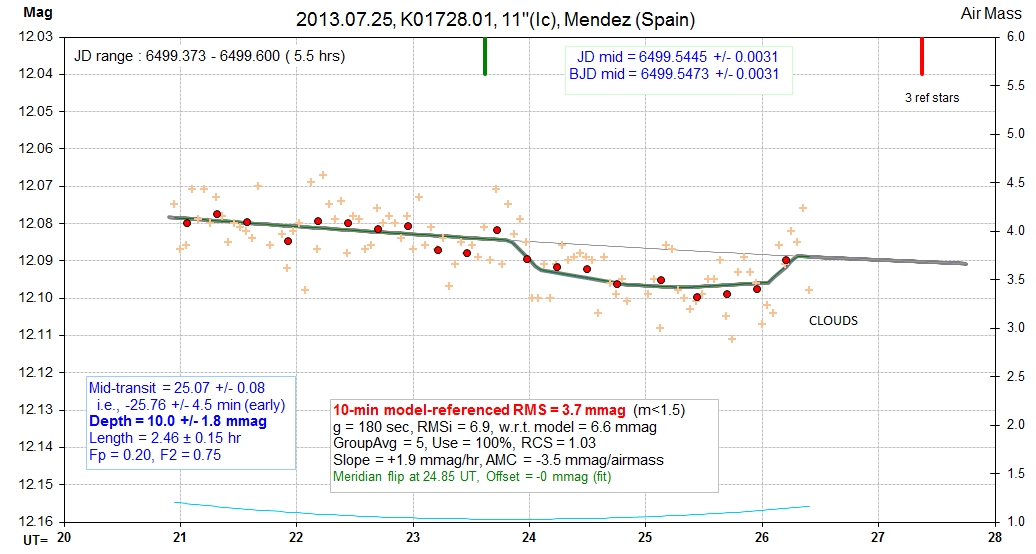
K01728.01 data
Egress is uncertain (due to possible cloud effects), so
mid-transit time is also uncertain. Depth agrees with
Kepler database (11.1 mmag).

K03782.01 data
Wow! We need to observe this one again! If the sinusoidal
variation is constant (as it should be if it's due to a "Delta
Scuti" type pulsation) we can expect to see a phase shift
equivalent to ~ 33 seconds if the secondary is an exoplanet. If
the secondary is another star (an EB system), the phase shifts
will be much larger, and easily detected from amateur
observations. This system therefore represents an opportunity for
amateurs to confirm the exoplanet status of a candidate discovered
by professional astronomers (perhaps for the first time). I urge
advanced amateurs to observe this star intently during the next 3
months for the purpose of detecting any variation of the
sinusoidal variation's phase. I can perform the phase stability
analysis; just submit LC data to me. Anyone interested in a
similar observing program by amateurs that relied upon an analysis
of phase stability of a sinusoidal variation can read the
paper at PDF link.
(Thanks to Siegfried Vanaverbeke for suggesting these
follow-through observations of K03782.)
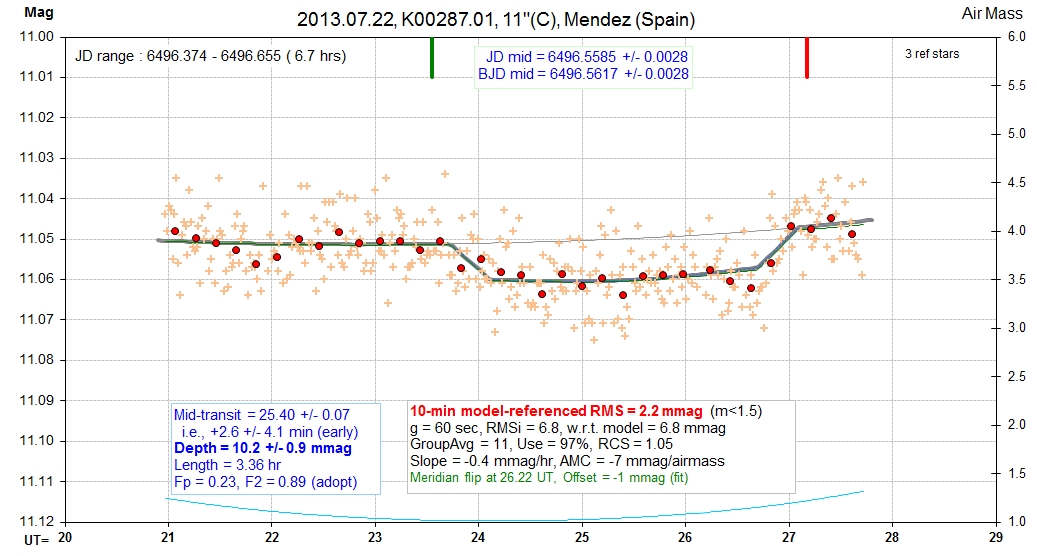
K00287.01 data
Nice LC! All Kepler catalog parameters are confirmed!
This sure looks like an exoplanet LC.

K00022.01 data
Confirms ephemeris & depth; length is slightly wider.

K01349.01 data
Kepler predicts depth = 27.0 mmag, mid-transit at 22.55 ±
0.01 UT. This is a confirmation observation, with refinement of
transit length.

K00405.01 data
This transit calls for a mid-transit time that is at
least 3.4 hours early, suggesting a large TTV effect. This
is not unreasonable given
that P = 37.614 days. Indeed, an investigation by Dan
Fabrycky predicted that this transit would occur at this very
early time! This LC is the first
example of a KAFO observation contributing
something of scientific value, and it illustrates how a 11-inch
amateur telescope can be used to study
Kepler candidate TTV. (A meridian flip occurs at 25.3 UT
and the meridian flip correction was solved for and found to be 0
mmag, which is typical
for this observer.)

K00410.01 data
First KAFO submission by veteran observer Joe Garlitz (GJP). Notice
that a 12-inch aperture telescope is capable of characterizing
transits of depth 5 mmag for a star with V-mag ~ 14.5. Kepler predicted depth = 4.3 mmag, mid-transit at
05.83 ± 0.03 UT, length =1.93
hrs. This is a confirmation observation.
Return to KAFO home page
____________________________________________________________________
WebMaster: B. Gary. Nothing on this web page is copyrighted. This
site opened: July 15, 2013


















































